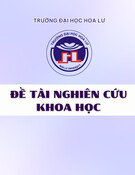
Original
article
Compared
sensitivity
of
seedlings
from
3
woody
species
(Quercus
robur
L,
Quercus
rubra
L
and
Fagus
silvatica
L)
to
water-logging
and
associated
root
hypoxia:
effects
on
water
relations
and
photosynthesis
E
Dreyer
INRA-Nancy,
Bioclimatologie
et
Écophysiologie,
Unité
d’Écophysiologie
Forestière,
F
54280
Champenoux,
France
(Received
7
June
1993; accepted
25
October
1993)
Summary -
Seedlings
of
Quercus
robur,
Q
rubra
and
Fagus
silvatica
were
submitted
to
a
period
of
partial
(water
table
at
6
cm
below
ground)
or
total
water-logging
for
4
weeks.
Important
disorders
were
induced
by
the
latter
treatment
in
growth
(root
decay,
partial
leaf
wilting),
water
relations
(decreased
predawn
water
potential)
and
photosynthesis
(stomatal
closure,
reduced
net
assimilation
rates,
lowered
O2
evolution
under
saturating
CO
2
and
irradiance,
and
limited
photochemical
efficiency
of
PS
II).
It
has
been
concluded
that
the
observed
stomatal
closure
was
accompanied
by
strong
disorders
at
chloroplast
level,
which
happened
without
visible
water-
logging-induced
deficiencies
in
mineral
nutrient
supply.
Reactions
to
partial
water-logging
were
much
more
limited.
F
silvatica
displayed
the
strongest
disorders
in
response
to
both
treatments,
Q
robur
showed
only
slight
stress
effects
in
response
to
partial
water-logging
and
Q
rubra
had
intermediate
behaviour.
These
observations
are
in
agreement
with
the
reported
differences
in
sensitivity
to
water-logging
of
adult
trees
in
the
stand.
The
precise
chain
of
events
leading
to
these
disorders
in
the
shoots
of
water-logged
seedlings
remains
to
be
elucidated.
stomatal
conductance
/
hydraulic
conductance
/
mineral
nutrition
/
photochemistry
/
photosystem
II
Abbreviations.
ψ
wm
and
ψ
wα
:
midday
and
predawn
leaf
water
potential
(MPa);
PFD:
photon
flux
density
(μmol
m
-2
s
-1);
A:
net
CO
2
assimilation
rate
(μmol
m
-2
s
-1);
gw:
leaf
conductance
to
water
vapour
(mmol
m
-2
s
-1);
ci:
intercellular
concentration
of
CO
2
(μmol
mol
-1);
Δw:
leaf
to
air
difference
in
vapour
mole
fraction;
gL:
specific
hydraulic
conductance
from
soil
to
leaves
(mmol
m
-2
s
-1
MPa
-1);
Fo,
Fm
and
Fo’,
Fm’:
basal
and
maximal
fluorescence
after
dark
adaptation
and
10
min
at
220
μmol
-2
s
-1
,
respectively;
Fv/Fm:
photochemical
efficiency
of
PS
II
in
dark-adapted
leaves:
ΔF/Fm’
and
Fv’/Fm’:
photochemical
efficiency
of
PS
II
and
of
open
PS
II
centres
after
10
min
at
a
given
irradiance
(220
or
800
μmol
m
-2
s
-1);
qp:
photochemical
quenching
of
fluorescence;
A
max
:
maximal
rate
of
photosynthetic
O2
evolution
under
5%
CO
2
and
800
μmol
mol
-1
irradiance
(μmol
O2
m
-2
s
-1),
C:
control
treatment;
PF:
partially
water-logged
treatment;
F:
completely
water-logged
treatment.

Résumé -
Sensibilité
de
jeunes
plants
de
chêne
pédonculé
(Quercus
robur
L),
de
chêne
rouge
d’Amérique
(Q
rubra
L)
et
de
hêtre
(Fagus
silvatica
L)
à
l’ennoyage
et
l’hypoxie
racinaire :
effets
sur
la
photosynthèse
et
les
relations
hydriques.
De
jeunes
plants
de
chêne
pédonculé
(Quercus
robur
L),
de
chêne
rouge
d’Amérique
(Q
rubra L)
et
de
hêtre
(Fagus
silvatica
L)
ont
été
soumis
à
un
ennoyage
total
(nappe
affleurant
en
permanence
à
la
surface
des
pots)
ou
partiel
(nappe
à
6
cm
sous
le
niveau
du
sol)
pendant
4
sem.
Le
premier
traitement
a
fortement
perturbé
la
croissance
des
plants
en
provoquant
une
importante
mortalité
racinaire.
Des
dysfonctionnements
majeurs
ont
aussi
été
constatés
sur
les
parties
aériennes :
diminution
du
potentiel
hydrique
de
base,
fermeture
des
stomates,
limitation
de
l’assimilation
nette
de
CO
2
et
de
la
capacité
photosynthétique
(mesurée
par
le
dégagement
d’O
2
en
conditions
de
CO
2
et
d’éclairement
saturants),
réductions
irréversibles
de
l’efficience
photochimique
du
phostosystème
II.
Le
second
a
provoqué
des
réactions
plus
limitées.
D’importantes
différences
interspécifiques
ont
été
constatées ;
F
silvatica
a
présenté
la
plus
grande
sensibilité,
avec
des
nécroses
foliaires
très
étendues,
et
des
réductions
massives
de
la
capacité
photosynthétique
dans
les
2
traitements,
alors
que
Q
robur
n’a
que
peu
réagi
à
l’ennoyage
partiel.
Ces
résultats
sont
en
accord
avec
les
observations
sur
les
exigences
écologiques
de
ces
espèces
en
peuplement.
Enfin,
elles
démontrent
que
les
désordres
imposés
à
la
photosynthèse
par
l’ennoyage
sont
dus
à
la
conjonction
d’une
fermeture
des
stomates
et
d’importants
dysfonctionnements
au
niveau
cellulaire,
qui
n’ont
pas
été
induits
par
une
dégradation
de
la
disponibilité
en
éléments
minéraux,
les
concentrations
totales
en
N,
P,
K,
Ca,
Mg,
S
mesurées
au
niveau
foliaire
n’ayant
que
peu
changé
au
cours
des
traitements.
conductance
stomatique
/
conductance
hydraulique
/
nutrition
minérale
/
photochimie
/
photosystème
II
INTRODUCTION
Temporary
water-logging
is
a
very
common
occurrence
in
the
plain
forests
of
north-east-
ern
France.
Oak
stands
in
particular
fre-
quently
grow
on
soils
with
temporary
high
water
tables,
which
produce
gleyic
or
pseudo-gleyic
accumulation
layers
in
the
soil
profile
(Becker and
Levy,
1986).
Water-
logging
has
both
direct
(poor
growth)
and
indirect
consequences
(shallow
rooting
pre-
disposing
trees
to
summer
water
stress)
for
tree
growth
and
productivity
(Becker
and
Levy,
1986).
Oak
species
present
different
sensitivities
to
this
constraint:
Quercus
robur
is
known
to
exhibit
a
lower
sensitivity
than
Q
petraea
to
direct
effects
of
soil
hypoxia,
but also
to
display
some
difficulties
in
coping
with
periods
of
drought
following
water-log-
ging
(Becker
and
Levy,
1986;
Levy
et
al,
1986).
Q
rubra,
which
is
now
widely
afforested
in
France,
is
suspected
to
be
even
more
water-logging
intolerant
than
both
the
indigenous
species
(Belgrand,
1983).
Fagus
silvatica
is
known
to
be
strongly
intolerant,
and
never
occurs
on
soils
in
which
temporary
water
tables
occur.
The
effects
of
water-logging
on
woody
species
have
frequently
been
analysed
(Kozlowski,
1982).
Water-logging
induces
soil
hypoxia
and
decreases
redox-potential
(Gambrell
et al,
1991)
which
may
impair
root
metabolism
(Konings
and
Lambers,
1991),
decrease
nitrogen
availability
through
denitrification
(Drew,
1983),
and
promote
the
accumulation
of
toxic
species
such
as
reduced
manganese
or
iron
cations
(Gam-
brell
et
al,
1991).
Root
dysfunctions
in
turn
induce
marked
stress
effects
on
shoots.
Reduced
root
hydraulic
conductance
(Andersen
et al,
1984;
Harrington,
1987;
Smit
and
Stachowiak;
1988)
has
sometimes
been
reported
to
promote
decreases
in
leaf
water
potential
(Zaerr,
1983;
Osonubi
and

Osundina,
1987).
Stomatal
closure
and
associated
decreases
in
net
CO
2
assimila-
tion
are
now
considered
as
general
responses
to
root
anoxia
(see,
for
instance
Dreyer et al,
1991;
Pezeshki,
1991;
Reece
and
Riha,
1991;
Topa
and
Cheeseman,
1992).
Reductions
in
growth,
appearance
of
leaf
necroses
and
decreases
in
leaf
nutri-
ent
contents
have
also
been
frequently
described
(Colin-Belgrand
et al,
1991;
Drew,
1991
).
The
physiological
mechanisms
leading
to
these
disorders
in
shoot
behaviour
are
poorly
understood.
It
is
now
widely
accepted
that
the
decreases
in
leaf
water
potential
due
to
reduced
hydraulic
conductance
do
not
form
the
trigger
mechanism
leading
to
stomatal
closure
during
water-logging,
and
that
hormonal
signals
must
be
involved.
Root
issues
abscisic
acid
(ABA)
is
thought
to
be
this
signal
during
water-logging
(Brad-
ford,
1983;
Jackson
and
Hall,
1987;
Zhang
and
Davies,
1987).
Large
amounts
of
ethy-
lene
are
issued
during
root
hypoxia
and
seem
to
induce
some
of
the
growth
reac-
tions
like
the
appearance
of
root
aerenchyma
(Jackson,
1985;
Voesenek
et
al,
1992),
but
an
involvement
in
stomatal
behaviour
and
photosynthesis
regulation
remains
to
be
demonstrated.
There
are
still
many
open
questions
about
how
leaf
pho-
tosynthesis
is
impaired.
Water-logging-
induced
decreases
of
net
CO
2
assimilation
rates
(A)
have
been
reported
to
occur
at
constant
or
even
increasing
values
of
inter-
cellular
CO
2
concentrations
(c
i)
(Pezeshki
and
Sundstrom,
1988;
Smith
and
Ager,
1988;
Dreyer
et al,
1991;
Vu
and
Yelen-
ovski,
1991),
which
would
mean
that
pho-
tosynthetic
processes
other
than
the
diffu-
sion
of
CO
2
through
stomata
are
impaired.
Calculation
of
ci
in
stressed
leaves
may
lead
to
artefacts
due
to
potential
non-uniform
stomatal
closure
(Terashima
et al,
1988),
and
the
above
results
need
therefore
to
be
confirmed
by
independent
methods
of
anal-
ysis.
Moreover,
the
site
of
primary
limita-
tions
of
photosynthesis
during
water-log-
ging
stress
has
still
to
be
identified.
In
the
present
work,
we
analyse
photo-
synthetic
functions
of
potted
seedlings
from
the
3
cited
tree
species
during
periods
of
water-logging
using
gas
exchange
mea-
surements
to
assess
stomatal
conductance
and
net
CO
2
assimilation
rates,
photosyn-
thetic
oxygen
evolution
under
high
CO
2
con-
centrations,
saturating
irradiance
to
esti-
mate
maximal
photosynthesis,
and
finally
chlorophyll-a
fluorescence
to
monitor
photo-
chemical
efficiency
of
PS
II.
MATERIAL
AND
METHODS
Plant
material
Acorns
of
Q
robur
L and
Q
rubra
L
were
collected
under
selected
individual
trees
in
the
Forêt
Doma-
niale
de
Manoncourt
en
Woëvre
(Meurthe
et
Moselle,
eastern
France)
and
in
the
Forest
of
Schopperten
(Moselle,
eastern
France)
during
Autumn
1989
and
kept
over-winter
in
a
cold
chamber
at
-1°C.
Sixty
seedlings
of
each
species
were
grown
in
a
sandy
loam
in
5
L,
25-cm-deep
pots
from
spring
1990
onwards
in
a
glasshouse
at
INRA
Champenoux,
under
natural
illumination
(irradiance
≈ 70%
of
external;
minimal
tempera-
ture
over winter
10°C,
maximal
temperature
dur-
ing
summer
30°C;
manual
watering;
fertilisation
with
30
g
slow
release
fertiliser
per
plant
on
June
12,
1990,
Nutricote
100,
N/P/K
13/13/13
+
oligo
elements).
Sixty
F silvatica
L
saplings
(1-year-
old
saplings
from
Office
National
des
Forêts,
Clair-
lieu
nursery
near
Nancy,
seed
collected
in
the
Forêt
Domaniale
de
Haye)
were
planted
into
sim-
ilar
pots
during
February
1990
and
grown
under
the
same
conditions.
At
the
end
of
1990,
mean
heights
and
stem
diameters
were:
473
± 7.3
and
7.58
± 0.24
mm,
331
±
7.1
and
6.48
± 0.23
mm,
356
±
4.05
and
6.67
±
0.38
mm
for
Q
robur,
Q
rubra and
F silvatica,
respectively.
Experimental
design
An
external
transparent
tubing
was
connected
to
the
bottom
of
the
pots,
allowing
a
precise
con-

trol
of
the
water
table.
Forty-eight
seedlings
were
selected
in
each
species,
and
randomly
dis-
tributed
into
3
treatments:
control
(C);
partially
flooded
to
6
cm
below
soil
surface
(PF);
and
com-
pletely
flooded
(F).
Water-logging
was
initiated
on
May
25
1991
with
tap
water;
the
level
of
the
water
table
was
controlled
every
day.
Under
such
conditions,
O2
partial
pressure
is
expected
to
drop
in
a
few
days
to
well
below
the
critical
oxy-
gen
pressure
for
root
tip
growth
(around
20
kPa)
or
even
for
older
root
maintenance
(5
kPa)
(Saglio
et al,
1984;
Drew,
1991)
and
soil
redox
potential
to
decrease
to
-100
to
-200
mV
(Gambrell
et
al,
1991).
The
characteristic
smell
for
methane
production
was
detected
in
our
pots
after
approx-
imately
8-10
d
of
water-logging.
Sapling
responses
to
these
conditions
were
tested
every
week
on
3
randomly
selected
individuals
in
each
species
x
treatment.
Midday
leaf
water-potential
(ψ
wm
)
was
measured
in
the
greenhouse
on
the
selected
individuals,
which
were
thereafter
trans-
ported
into
a
growth
chamber
with
following
cli-
mate:
temperature
22/16°C;
16/8
h
day/night;
irradiance
around
300
μmol
m
-2
s
-1
.
Chlorophyll-
a
fluorescence
and
oxygen
evolution
at
5%
CO
2
were
measured
the
following
morning,
and
gas
exchange
monitored
on
2
leaves
per
plant
in
the
afternoon,
after
at
least
4
h of
illumination.
Predawn
leaf
water
potential
(ψ
wm
)
was
mea-
sured
during
next
morning
and
all
saplings
were
harvested
for
biomass,
chlorophyll
content,
and
nutrient
composition
determination.The
whole
procedure
was
repeated
every
week
from
week
1
to
4
after
beginning
of
water-logging.
Twelve
saplings
had
been
analysed
per
species
and
treatment
at
the
end
of
the
experiment.
Photosynthesis
and
water
relations
ψ
wm
and
ψ
wd
were
measured
on
2
leaves
per
individual
with
a
pressure
chamber.
Gas
exchange
was
monitored
with
a
portable
photo-
synthesis
chamber
Li
Cor
6200
on
2
leaves
per
plant.
Mean
values
±
confidence
intervals
of
microclimate
during
measurements
were
as
fol-
lows:
PFD:
310
±
2
μmol
m
-2
s
-1
;
leaf
tempera-
ture:
26.1
±
0.2°C;
CO
2
concentration
in
air:
422
±
2
μmol
mol
-1
;
leaf
to
air
difference
in
water
vapour
(Δw):
20.0
± 0.4
Pa
kPa
-1
.
Leaf
area
was
determined
with
a
ΔT planimeter.
Results
were
computed
as
in
Ball
(1987)
(net
assimilation
rate,
A,
μmol
m
-2
s
-1
:
leaf
conductance
to
water
vapour
gw,
mmol
m
-2
s
-1
;
and
intercellular
concentration
of
CO
2,
ci,
μmol
mol
-1),
and
presented
as
A/c
i
relationships
(Guehl
and
Aussenac,
1987).
We
computed
the
specific
(ie
related
to
leaf
area)
hydraulic
conductance
from
soil
to
leaves
as:
gL
=
gw
•
Δ
w
(ψ
wd -
ψ
wm),
according
to
Reich
and
Hinckley (1989).
Chlorophyll
fluorescence
and
oxygen
evolution
Chlorophyll-a
fluorescence
from
photosystem
II
(PS
II)
was
recorded
at
wavelengths
around
690
nm
at
ambient
temperature
with
a
pulse
ampli-
tude
modulated
fluorometer
(PAM
101,
Walz,
Germany),
using
the
procedure
described
by
Epron
and
Dreyer
(1992).
Leaf
disks
(20
mm
diameter)
were
punched
from
seedlings
kept
in
darkness
overnight,
and
inserted
into
a
temper-
ature-controlled
leaf-disk
holder
(22°C).
Initial
fluorescence
(Fo)
was
determined
with
a
pulsed
light-emitting
diode
(<
10
mW
m
-2
)
at
a
frequency
of
1.6
kHz;
maximal
fluorescence
(Fm)
was
obtained
with
an
oversaturating
flash
of
white
light
(0.7
s;
4
000
μmol
m
-2
s
-1
;
Schott
KL
1
500N
FRG).
The
optimal
photochemical
efficiency
of
PS
II,
eg
after
complete
relaxation
in
the
dark
(Krause
and
Weis,
1984;
Genty
et al,
1987),
was
estimated
from
the
ratio
Fv/Fm
=
(Fm -
Fo)/
Fm.
After
10
min
exposure
to
actinic
white
light
(Schott
KL1500,
FRG,
220
μmol
m
-2
s
-1),
an
additional
white
light
flash
allowed
computation
of
the
photo-
chemical
efficiency
of
PS
II
according
to
Genty
et al
(1989)
from
ΔF/Fm’ were
ΔF =
Fm’-F (F:
level
of
steady-state
fluorescence,
and
Fm,
fluo-
rescence
during
a
saturation).
Basic
fluorescence
(F0)
was
recorded
immediately
after
switching
off
actinic
illumination,
and
used
to
compute
the
photochemical
efficiency
of
open
PS
II
reaction
centres
as:
Fv’/Fm’
= (Fm’-Fo’)/Fm’.
Photo-
chemical
quenching,
ie
the
fraction
of
open
PS
II
reaction
centres,
was
computed
according
to
Genty
et al (1989)
as:
qp
=
(Fv’/Fm’)
/
(ΔF/Fm’).
A
second
period
of
induction
was
imposed
imme-
diately
thereafter
(10
min,
800 μmol
m
-2
s
-1),
and
the
same
parameters
recorded.
Maximal
photosynthetic
O2
evolution
rate
(A
max
,
μmol
O2
m
-2
s
-1
)
was
measured
on
a
sec-
ond
leaf
disk
with
an
oxygen
electrode
assembly
(LD2
MK2,
Hansatech,
UK,
22°C,
N2
+
O2
+
CO
2:
80/15/5%).
A
period
of
20
min
induction
under
an
irradiance
of
800
μmol
m
-2
s
-1
(Light
Unit
LS2,
Hansatech,
UK)
was
provided
before
the
mea-
surements.

Specific
leaf
weight
(g
dm-2
,
oven-dried
at
85°C
for
24
h)
and
total
chlorophyll
content
(3
ml
DMSO,
incubation
at
60°C
during
90
min,
opti-
cal
densities
measured
at
663
and
645
nm,
according
to
Hiscox
and
Israeltam,
1979)
were
determined
on
the
same
disks.
Leaf
nutrient
content
Saplings
were
separated
into
leaf,
stem
and
root
compartments,
and
oven-dried
at
85°C
for
dry-
weight
determination.
Total
mineral
content
was
measured
as
follows.
Samples
were
crushed
(Tecator-Cyclotrec
1093
Sample
Mill)
and
total
nitrogen
was
measured
with
an
autoanalyzer
Technicon
after
mineralization
with
H2
SO
4
and
H2O2,
and
all
other
elements
(S,
P,
Mn,
Mg,
Ca,
K)
were
quantitated
with
an
ICP
(Jobin
Yvon
JY
438
Plus)
after
a
mineralization
with
HClO
4
and
H2O2.
Statistical
analysis
of
results
Due
to
the
rapidity
of
reactions
to
water-logging,
many
parameters
were
strongly
modified
during
week
1,
but
showed
no
significant
evolution
from
week
1
to
week
4.
We
therefore
pooled
the
data
together,
and
analysed
them
as a
factorial
design
(
3
species
x
3
treatments
x
12
individuals).
Results
are
presented
as
means
±
standard
error
of
the
mean.
RESULTS
Growth
and
external
signs
of
water-logging
stress
Flooding
was
imposed
during
a
period
of
active
growth
in
all
species.
The
height
growth
of
F silvatica
was
slow
(due
to
strong
ramification
and
sympodial
growth
in
this
species).
Growth
was
completely
stopped
on
all
species
by
the
total
(F)
and
partial
(PF)
water-logging
treatments.
Visual
symp-
toms
induced
by
water-logging
were
very
different
among
species.
In
F silvatica,
F
induced
visible
signs
of
leaf
necrosis
after
1
week
(brown
spots
at
leaf
margins);
these
necroses,
together
with
brown
spots
along
vascular
bundles,
progressively
spread
over
the
whole
leaf
laminae
in
the
following
weeks.
Surprisingly,
after
3
weeks,
new
growth
was
initiated,
and
short
shoots
with
tiny,
vitreous
leaves
were
formed,
while
the
primary
foliage
decayed
progressively.
No
epinasty
was
observed.
Root
systems
dis-
played
a
strong
decay
with
no
lenticels
and
no
new
root
formation.
PF
induced
analo-
gous
symptoms
with
less
severity
and
a
week’s
delay;
roots
survived
in
the
upper,
unflooded
soil
layer
but
no
additional
root
growth
occurred
there.
New
leaf
formation
was
slightly
more
intense
than
in
F.
Oaks
displayed
very
different
symptoms.
F
saplings
never
showed
leaf
necrosis,
but
sometimes
very
strong
epinasty
after
2
weeks.
On
a
few
individuals,
epinastic
leaves
dried
out
very
rapidly
during
days
with
high
VPD
and
temperature
(around
30°C).
Root
systems
of
Q
robur
and
Q
rubra
behaved
differently.
While
F
induced
almost
the
same
intensity
of
root
decay,
with
no
appreciable
growth,
no
lenticels
and
no
adaptive
feature
to
water-logging,
PF
allowed
growth
of
new
roots
in
the
non-flooded
soil
layer
on
Q
robur
alone,
and
none
at
all
on
Q
rubra.
Newly
grown
roots
were
thick,
non-ramified
and
white
along
their
whole
length.
Their
forma-
tion
began
from
the
third
week
on
wards.
This
observation
is
in
agreement
with
that
made
earlier
by
Colin-Belgrand
et al (1991)
on
the
same
species.
Figure
1
displays
the
total
biomass
of
the
saplings.
Reductions
in
root
biomass
were
very
significant
due
root
decay
in
the
F
treat-
ments.
Shoot
biomass
was
less
affected,
and
only
a
fraction
of
the
leaves
completely
dried
out.
Water
relationships
Water
relationships
were
strongly
affected
by
the
water-logging
(table
I).
Significant


























